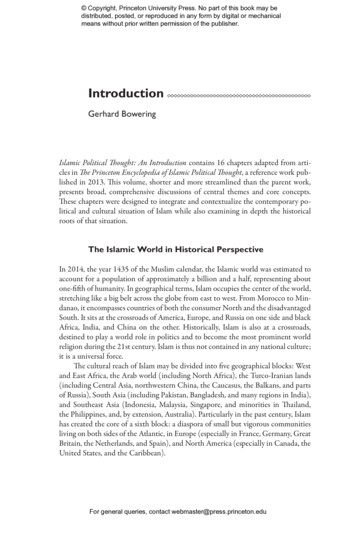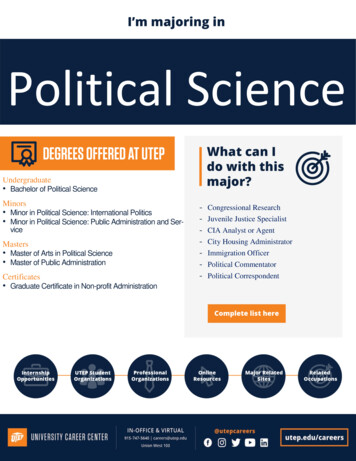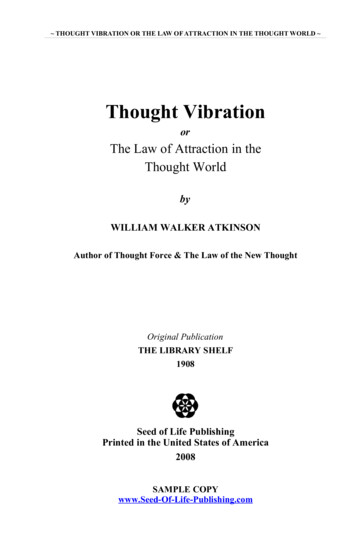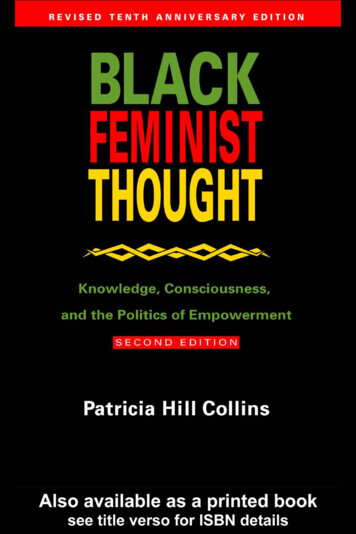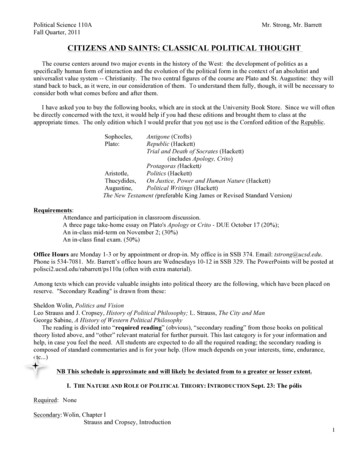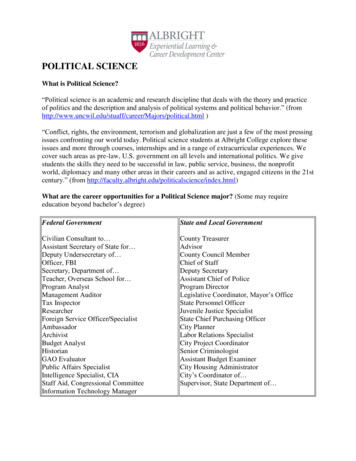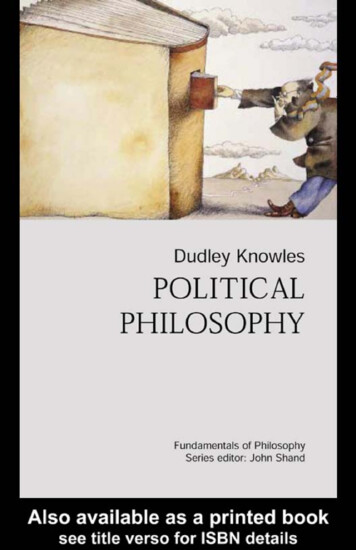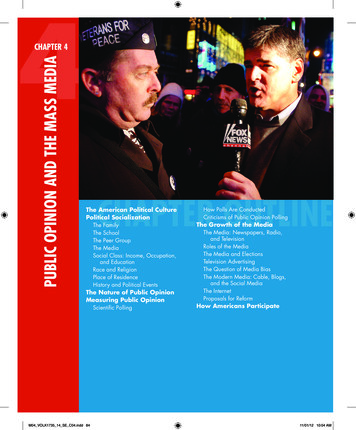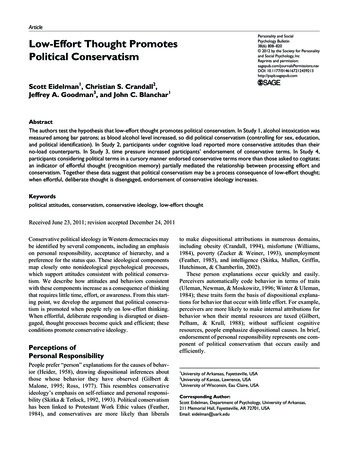
Transcription
439213an et al.Personality and Social Psychology ePersonality and SocialPsychology Bulletin38(6) 808 –820 2012 by the Society for Personalityand Social Psychology, IncReprints and permission:sagepub.com/journalsPermissions.navDOI: -Effort Thought PromotesPolitical ConservatismScott Eidelman1, Christian S. Crandall2,Jeffrey A. Goodman3, and John C. Blanchar1AbstractThe authors test the hypothesis that low-effort thought promotes political conservatism. In Study 1, alcohol intoxication wasmeasured among bar patrons; as blood alcohol level increased, so did political conservatism (controlling for sex, education,and political identification). In Study 2, participants under cognitive load reported more conservative attitudes than theirno-load counterparts. In Study 3, time pressure increased participants’ endorsement of conservative terms. In Study 4,participants considering political terms in a cursory manner endorsed conservative terms more than those asked to cogitate;an indicator of effortful thought (recognition memory) partially mediated the relationship between processing effort andconservatism. Together these data suggest that political conservatism may be a process consequence of low-effort thought;when effortful, deliberate thought is disengaged, endorsement of conservative ideology increases.Keywordspolitical attitudes, conservatism, conservative ideology, low-effort thoughtReceived June 23, 2011; revision accepted December 24, 2011Conservative political ideology in Western democracies maybe identified by several components, including an emphasison personal responsibility, acceptance of hierarchy, and apreference for the status quo. These ideological componentsmap closely onto nonideological psychological processes,which support attitudes consistent with political conservatism. We describe how attitudes and behaviors consistentwith these components increase as a consequence of thinkingthat requires little time, effort, or awareness. From this starting point, we develop the argument that political conservatism is promoted when people rely on low-effort thinking.When effortful, deliberate responding is disrupted or disengaged, thought processes become quick and efficient; theseconditions promote conservative ideology.Perceptions ofPersonal ResponsibilityPeople prefer “person” explanations for the causes of behavior (Heider, 1958), drawing dispositional inferences aboutthose whose behavior they have observed (Gilbert &Malone, 1995; Ross, 1977). This resembles conservativeideology’s emphasis on self-reliance and personal responsibility (Skitka & Tetlock, 1992, 1993). Political conservatismhas been linked to Protestant Work Ethic values (Feather,1984), and conservatives are more likely than liberalsto make dispositional attributions in numerous domains,including obesity (Crandall, 1994), misfortune (Williams,1984), poverty (Zucker & Weiner, 1993), unemployment(Feather, 1985), and intelligence (Skitka, Mullen, Griffin,Hutchinson, & Chamberlin, 2002).These person explanations occur quickly and easily.Perceivers automatically code behavior in terms of traits(Uleman, Newman, & Moskowitz, 1996; Winter & Uleman,1984); these traits form the basis of dispositional explanations for behavior that occur with little effort. For example,perceivers are more likely to make internal attributions forbehavior when their mental resources are taxed (Gilbert,Pelham, & Krull, 1988); without sufficient cognitiveresources, people emphasize dispositional causes. In brief,endorsement of personal responsibility represents one component of political conservatism that occurs easily andefficiently.1University of Arkansas, Fayetteville, USAUniversity of Kansas, Lawrence, USA3University of Wisconsin, Eau Claire, USA2Corresponding Author:Scott Eidelman, Department of Psychology, University of Arkansas,211 Memorial Hall, Fayetteville, AR 72701, USAEmail: eidelman@uark.edu
809Eidelman et al.Acceptance of HierarchyPeople accept and maintain status differences between people and groups (Berger, Cohen, & Zelditch, 1972; Jost &Banaji, 1994; Ridgeway, 1991; Sidanius & Pratto, 1999).This acceptance of hierarchy is also a core component ofpolitical conservatism (Bobbio, 1996; Jost, Glaser, Kruglanski,& Sulloway, 2003). Research links acceptance of hierarchyto political conservatism empirically (Pratto, Sidanius,Stallworth, & Malle, 1994), and opposition to equality isrelated to endorsement of conservative social policies (Jost& Thompson, 2000).Acceptance of hierarchy is also simple and efficient.Status distinctions are discerned quickly (Moors & DeHouwer, 2005) and easily (e.g., when only “thin slices” ofinformation are available; see Ambady, Bernieri, & Richeson,2000; Costanzo & Archer, 1989). Members of low statusgroups accept status differences implicitly (Jost, Pelham, &Carvallo, 2002; Rudman, Feinberg, & Fairchild, 2002), andpeople maintain interpersonal hierarchical differentiation bycomplementing the dominant or submissive posture of aninteraction partner (by being more submissive or dominant,respectively) without awareness of doing so (Tiedens &Fragale, 2003). Zitek and Tiedens (2011) found that hierarchy is perceived, remembered, and learned more easily (andliked more) than nonhierarchical arrangements. Togetherthese data indicate that acceptance of hierarchy—a secondcomponent of political conservatism—proceeds in theabsence of effortful information processing.Preference for the Status QuoPreference for the status quo represents a third component ofpolitical conservatism (Bobbio, 1996; Burke, 1790/1999;Jost et al., 2003; McClosky & Zaller, 1984; Stone, 1994). Ahost of psychological mechanisms advantage the processingand endorsement of the status quo. What comes first impactsjudgment more than what comes later (Asch, 1946; Jones &Goethals, 1972), established decisions tend to be repeated inthe future (Samuelson & Zeckhauser, 1988), and the familiaris experienced more favorably (Festinger, Schachter, &Back, 1950; Zajonc, 1968). Across several domains, perceivers simply assume that existing and long-standing statesare good and desirable (Eidelman, Crandall, & Pattershall,2009; Eidelman, Pattershall, & Crandall, 2010).These mechanisms operate quickly and efficiently.Primacy effects are enhanced under time pressure (Kruglanski& Freund, 1983), and the effect of exposure on evaluation isstrongest when stimuli are processed outside of awareness(Bornstein, 1989; Bornstein & D’Agostino, 1992). Statusquo bias increases as a function of the number of alternatives, implying a simple and efficient strategy (Kempf &Ruenzi, 2006). Participants’ preference for existing states isunaffected by having their mental resources taxed (Eidelmanet al., 2009), and they seem unaware that time in existenceincreases liking (Eidelman et al., 2010). These findings indicate that status quo endorsement—another component ofpolitical conservatism—requires little time, effort, andawareness (Eidelman & Crandall, 2009).Low-Effort Thoughtand Political ConservatismEmphasis on personal responsibility, acceptance of hierarchy, and preference for the status quo are linked to fast andefficient ways of processing information; each may bequickly and easily endorsed, often outside of awareness andwith little or no effort. Because these and other componentsof political conservatism (e.g., self-interest; Moore &Loewenstein, 2004; van den Bos, Peters, Bobocel, &Ybema, 2006) are closely linked to automatic, default processes, we predict that restricting people to simple and basicmodes of thought will lead to the acceptance of conservativeattitudes and values. Taxing, limiting, or otherwise disengaging effortful, deliberative thought should increaseendorsement of conservative ideology.Alternatively, low-effort thought might promote politicalconservatism because its concepts are easier to process, andprocessing fluency increases attitude endorsement (Alter &Oppenheimer, 2009). Another form of this argument is thatthose who espouse politically conservative attitudes andopinions handle ideological information in a more cursorymanner (e.g., Tetlock, 1983). These ideas have support, butare distinct from our claim. We argue that low-effort information processing promotes the ideological content of political conservatism. When time and effort are in short supply,emission of responses consistent with conservative ideologyshould increase.The motivated social cognition approach of Jost and hiscolleagues also underscores the content of conservative ideology (Jost et al., 2003; Jost et al., 2007). These researchersargue that the endorsement of political conservatism stemsfrom needs to manage threat and uncertainty; the stability,predictability, and certainty attached to conservative political concepts are thought to provide an additional meansthrough which these needs might be secured (Chirumbolo,Areni, & Sensales, 2004; Jost et al., 2003). The motivatedsocial cognition account emphasizes how conservatism iswell suited to satisfy epistemic and security needs, but weunderscore how conservative ideology will arise as a processconsequence of low-effort thought. Low-effort processingmay be used independent of needs for stability and certainty;our account is that low-effort thought alone will promotepolitical conservatism.We tested these ideas in four studies. Study 1 was conducted in vivo at a local bar, with alcohol intoxication serving as a hindrance to effortful thinking; political attitudes ofbar patrons were correlated with a measure of their bloodalcohol content (BAC). In Study 2, we measured participants’ political attitudes under normal working conditions or
810cognitive load. In Study 3, we manipulated time pressure andmeasured the endorsement of terms related to liberal andconservative beliefs. We expected alcohol, load, and timepressure to interfere with effortful information processing,leaving participants to lean more heavily on thinking thatwas easy and efficient. In Study 4, we manipulated effortfulprocessing directly by asking participants to consider political terms in a deliberate or cursory manner. In all studies,we expected low-effort thought to promote conservativeideology.Study 1In Study 1, we took advantage of alcohol consumption as acommon and powerful means of disrupting deliberativethought. Alcohol restricts cognitive capacity and impairscontrolled responding (e.g., Abroms, Fillmore, & Marczinski,2003; Easdon & Vogel-Sprott, 2000) while leaving automatic thinking largely intact (Bartholow, Dickter, & Sestir,2006; Fillmore, Vogel-Sprott, & Gavrilescu, 1999; Herzog,1999). If low-effort thought promotes political conservatism, the inability to process information thoroughly andoverride simple responding associated with increasing levelsof alcohol intoxication should lead to the expression of moreconservative attitudes.MethodParticipants and procedure. Eighty-five community members (29% female) who were patrons of a local New Englandbar participated without remuneration. Mixed-sex groups of3 to 4 experimenters obtained permission to stand outside thebar’s busiest exit and approach potential participants as theyleft. Participants were asked to complete a short survey aboutsocial attitudes in exchange for learning their BAC. Beforecollecting data, experimenters verified that each participantwas at least 21 years of age and not driving. Those who metthese criteria completed a short survey and then blew into abreathalyzer. Participants were apprised of their BAC andthanked for their assistance. They were given contact information so they could rescind participation at a later date ifthey saw fit (none did).Measurement of political conservatism. Participants completed a short survey that contained 10 items drawn fromEysenck (1951, 1975) that tapped various aspects of politicalconservatism (e.g., “Production and trade should be free ofgovernment interference” and “Ultimately, privately property should be abolished”). All items were answered on9-point Likert-type scales (1 strongly disagree; 9 stronglyagree) and combined to form an index of political conservatism (α .62) with higher numbers, reverse-scored wherenecessary, indicating more conservative political attitudes.Demographics. Participants also indicated how much education they had (1 some high school; 2 high schooldiploma; 3 some college; 4 college degree; 5 mastersPersonality and Social Psychology Bulletin 38(6)degree; 6 doctorate or equivalent) and their self-identificationas liberal/conservative (1 very liberal; 5 very conservative). An experimenter coded participants’ sex as either maleor female.Measurement of BAC. BAC was assessed with an AlcoSensor FST breathalyzer (Intoximeters Inc., St. Louis, MO).Participants were asked to blow a steady stream of air intothe breathalyzer until told to stop (when the LCD of thebreathalyzer displayed a reading, typically 2 to 3 s fromwhen the participant started to blow). Breathalyzers werecalibrated prior to data collection and fresh mouthpieceswere used for each participant.ResultsParticipants averaged some college education (M 3.77,SD 0.73), and they can be described ideologically as centrists (M 2.45, SD 1.05). Participants’ mean BAC levelwas .058, with a range of .00 to .18, and their mean endorsement of political conservatism was 4.96, with a range of 2.2to 7.8. Self-identification as liberal/conservative was unrelated to BAC, r .14, p .18.1To determine whether BAC was related to political conservatism, we regressed the 10-item conservatism index onparticipants’ self-identification as liberal/conservative, sex(0 male; 1 female), level of education, and BAC.Consistent with predictions, BAC was a significant predictorof political conservatism, β .21, t(82) 2.40, p .02, overand above ideological self-identification, sex, and education.Not surprisingly, self-identification was also a significantpredictor of participants’ political conservatism, β .68,t(82) 7.82, p .0001, but neither sex (β .01) nor level ofeducation (β .06) predicted political conservatism in themodel (both ps .45).We performed an additional regression analysis thatincluded a squared BAC term and the interaction betweenideological self-identification and BAC as additional predictors in the model to test for the possibility that the effect ofBAC on political conservatism was (respectively) curvilinear or dependent on participants’ self-identification as liberalor conservative (these terms were computed after relevantvariables were centered to control for multicollinearity;Cohen, Cohen, West, & Aiken, 2003). Neither of these predictors were related to political conservatism (both ps .94),whereas the effect of BAC on political conservatismremained significant (p .05).DiscussionBar patrons reported more conservative attitudes as their levelof alcohol intoxication increased. Because alcohol limits cognitive capacity and disrupts controlled responding, while leaving automatic thinking largely intact (e.g., Bartholow et al.,2006), these data are consistent with our claim that low-effortthinking promotes political conservatism.
811Eidelman et al.In Study 2, we manipulated reliance on low-effort thought.Participants indicated their political attitudes by responding toseveral statements; half did so while their cognitive resourceswere depleted by working on a second task concurrently (e.g.,Gilbert et al., 1988; Wegner & Erber, 1992). With their attention divided, participants with depleted resources should beless able to engage in deliberative thinking when reportingtheir political attitudes. If the output of low-effort thought isconsistent with conservative ideology, participants withdepleted resources should indicate more conservative attitudes than those with ample cognitive resources.We also measured political liberalism in addition to political conservatism. Liberal political beliefs may be independent of conservative beliefs (e.g., Kerlinger, 1967, 1984),particularly among nonexperts (Sidanius & Duffy, 1988) andthose unmotivated to form opinions (Federico, 2007), and soour hypothesis is largely silent on the relationship betweendeliberate thought and liberalism. We made no firm predictions about the effect of load on liberalism other than toexpect a pattern distinct from the effects of load on conservatism, which would indicate that load’s effect is not due toacquiescence or other nuisance processes.We also measured participants’ mood to ensure thatchanges in political attitudes under cognitive load were notdue to temporary changes in affect. To ensure that any effectof load was not due to differences in ease of processing orunderstanding, we asked an independent sample of participants to respond to the statements while we recorded responsetimes, and another to rate each statement for its complexity.Statements were also compared for reading difficulty.psychology course participated in exchange for extra credit.Participants were run in small groups but worked independently. Each session was randomly assigned to one level of acognitive load manipulation.Procedure. Participants provided informed consent andthen were given 15 min to complete a packet about socialperception. Before beginning, half of the sessions were givenan additional set of instructions to manipulate cognitive load.After completing their packets, participants were debriefed,thanked, and dismissed.Measure of political attitudes. Participants indicated theirpolitical attitudes using Kerlinger’s (1984) Social AttitudesStatement Scale (SASS). The SASS treats liberalism andconservatism as distinct constructs. Thirteen items make upa liberalism subscale (e.g., “Large fortunes should be taxedfairly heavily over and above income taxes”; α .69), and 13items make up a conservatism subscale (e.g., “A first consideration of any society is the protection of property rights”;α .69). All items were answered on 7-point Likert-typescales (1 strongly disagree; 7 strongly agree), withhigher numbers indicating more of each construct. The subscales were uncorrelated, r .08, p .61.Mood. Participants then completed the Brief Mood Introspection Scale (BMIS; Mayer & Gaschke, 1988). The BMISasks participants to indicate how they are feeling (e.g.,active, sad, fed up) at the moment and has separate subscalesfor valence and arousal. We also included two additionalterms, frustrated and annoyed, to have a more nuanced measure of affect in response to our load manipulation. Responsesranged from 1 (definitely do not feel) to 4 (definitely feel).Ease of processing and complexity. To measure ease of processing of the liberal and conservative statements, we askedan independent sample of 13 participants drawn from thesame population to complete the SASS on a computer whilewe recorded response times. To measure the complexity ofthese statements, an independent sample of 19 participantsdrawn from the same population rated “the idea behind eachstatement” for its complexity. Responses were made on a 1(easy to understand) to 9 (difficult to understand) scale. Wealso used Coh-Metrix software (McNamara, Louwerse, Cai,& Graesser, 2005) to rate the statements on four reading difficulty variables.Manipulation of cognitive load. Participants in half of thegroups were randomly assigned to work on a distraction taskwhile filling out their questionnaires. Load participants wereinstructed to listen to a tape of tones varying in pitch and tocount and record the number of tones that preceded eachchange (see Skitka et al., 2002). They were urged to be accurate and told that their responses would be checked for errors.No Load participants were not given these instructions, nordid they listen to tones while working on their questionnaires.MethodResultsParticipants and design. Thirty-eight undergraduates from theUniversity of Maine (89% female) enrolled in an introductoryPolitical attitudes. We computed t tests for the conservatism and liberalism subscales of the SASS. Consistent withThe interaction between BAC and self-identification asliberal/conservative was not significant, indicating that therelationship between BAC and conservatism held for thosewho leaned to the political left and the political right. AsBAC increased and capacity for deliberative thoughtdecreased, liberal and conservative participants shiftedtoward conservatism.Our data are correlational, and the possibility of reversecausality remains—political conservatives may drink morealcohol. Although BAC was correlated with endorsement ofpolitically conservative attitudes, it was unrelated to selfidentification as liberal/conservative, and BAC predictedconservative attitudes when self-identification was statistically controlled. This suggests that a predisposition to ideological conservatism does not account for our results. Indeed,there is reason to expect that willingness to imbibe is, in general, negatively correlated with political conservatism (e.g.,Margulies, Kessler, & Kandel, 1977).2Study 2
812Personality and Social Psychology Bulletin 38(6)5load nor were participants’ self-reported frustration andannoyance. Similarly, the complexity and ease of processingof conservative and liberal statements did not differ. Theseare unlikely causes of the differential endorsement of conservatism and liberalism across load conditions.4.543.5Study 332.5Conserva smLiberalismNo LoadLoadFigure 1. Endorsement of political conservatism and politicalliberalism as a function of cognitive loadpredictions, load increased conservative attitudes (M 3.68,SD 0.62) compared with the no load condition (M 3.25,SD 0.68), t(37) 2.02, p .05, η2 .10 (see Figure 1).Load decreased liberal attitudes (M 4.23, SD 0.62) compared with the no load condition (M 4.66, SD 0.56),t(37) 2.17, p .04, η2 .12.Mood. We also computed t tests to determine the effectsof load on the valence and arousal subscales of the BMIS.Neither effect was significant, both ts 1, ps .38. Load alsodid not affect participants’ frustration or annoyance, eitherseparately or when combined together, all ps .19.Ease of processing and complexity. To ensure that conservative and liberal statements did not differ in how easy theywere to process, response times to each were averaged andcompared with a t test. These times did not differ, t(12) .30,p .75. We also computed a paired samples t test on participants’ ratings of how easy statements were to understand;conservative and liberal statements did not differ, t(18) .34,p .73.Using the Coh-Metrix analysis of complexity (Graesser,McNamara, Louwerse, & Cai, 2004), we compared liberaland conservative statements and found no differences in thenumber of words per statement or the number of syllablesper words, and no differences in the Flesch Reading EaseScore or the Flesch–Kincaid Grade Level, all ps .30.DiscussionParticipants under cognitive load reported more conservative attitudes than those not under cognitive load. Becausecognitive load depletes available mental resources (Gilbertet al., 1988; Wegner & Erber, 1992), participants were leftto draw more heavily on thinking that was easy and efficient.We maintain that this thinking promotes political conservatism. Cognitive load also produced a corresponding shift inliberal attitudes; when under load, participants’ endorsementof political liberalism decreased.Mood was not responsible for changes in participants’political attitudes. Neither the arousal or valence scales ofthe BMIS were affected by our manipulation of cognitiveTime pressure also disrupts effortful thinking, forcingresponses that are quick and efficient (e.g., Bargh & Thein,1985; Strack, Erber, & Wicklund, 1982; Wegner & Erber,1992). We predicted that these conditions would promoteconservative ideology. We operationalized conservativeideology in Study 3 as the endorsement of conservativewords and phrases.Hansson, Keating, and Terry (1974) considered a similarhypothesis and gave participants either 2 min or unlimitedtime to respond to several ballot initiatives; time-pressedparticipants showed more support for ballot initiatives thatcould be considered politically conservative. We do notknow whether low-effort thinking led to favoring politicalconservatism; the conservative initiatives may have beeneasier to understand and thus more appealing. Two minutesfor reading, thinking about, and voting on several ballot initiatives might well have created arousal or negative mood,which could in turn lead to more conservative-consistentchoices. We developed a study that provides a clearer test oftime pressure’s effect on political attitudes. We again measured political liberalism separately from political conservatism, allowing us to distinguish potential changes for eachideology separately. This distinction could not be discernedfrom the results reported by Hansson and his colleagues.MethodParticipants. Thirty-six undergraduates from the Universityof Maine (53% female) who were enrolled in introductorypsychology courses participated in exchange for extra credit.Participants were run individually and randomly assigned toone level of a time pressure manipulation.Procedure. Participants were taken to a small room with acomputer and informed consent was obtained. Instructionsand measures were presented on the monitor. Participantswere oriented to a button box with which they were told toindicate their responses.Participants read that the study concerned social issuesand that soon they would respond to some words and phrases.After completing practice trials, participants endorsed 50terms under high or low time pressure. They then respondedto 18 mood items and provided demographic information.Completion of the study took approximately 15 min.When finished, participants were debriefed, thanked, anddismissed.Time pressure manipulation. In the high time pressure condition, participants were instructed to respond to each termquickly without sacrificing accuracy. Terms appeared on the
813Eidelman et al.screen for 550 ms, followed by a response scale that remainedon the screen for 1,000 ms. Thus, participants had 1,550 msto read and respond to each term. We chose this time framebased on Bargh and Thein (1985) and pretesting indicatingthat errors (nonresponses in the allotted time) were kept to aminimum. If no response was given within 1,550 ms, a message appeared on the screen asking the participant to respondmore quickly.In the low time pressure condition, participants wereinstructed to take as long as needed to respond. Termsappeared on the screen for 4,000 ms before participantscould respond; then a response scale appeared and remainedon the screen until participants indicated their response.Participants in both conditions completed 10 practice trialsbefore the first block of terms to become acquainted with theforthcoming time requirement.Measurement of political attitudes. Participants completedKerlinger’s (1967, 1984) Social Referent Scale (SRS). Thisscale is similar to the SASS, but instead of statements foritems, it contains 25 terms that make up a conservatism subscale (e.g., law and order, authority, and private property)and 25 terms that make up a liberalism subscale (e.g., laborunions, civil rights, and social change). All responses weremade on scales ranging from 3 (strongly disagree) to 3(strongly agree). (One term, government price controls, wasremoved from the liberalism subscale because more than15% of participants in the high time pressure condition wereunable to respond in the allotted time, and responses to thisitems were negatively correlated with the remaining items.)The subscales were reliable (αs .84 and .78 for conservatismand liberalism, respectively) and uncorrelated, r .17, p .31.Mood. After responding to these terms, participantsreported their mood on the BMIS. Responses were made onthe same 3 to 3 scale.Ease of processing and complexity of terms. We recordedresponse times to terms as an indicator of ease of processing.We also asked an independent sample of 22 participantsdrawn from the same population to rate “the idea behindeach term” for its complexity. Responses were made on a 1(easy to understand) to 9 (difficult to understand) scale.ResultsPolitical attitudes. We computed t tests for the conservatism and liberalism subscales of the SRS. Consistent withpredictions, time pressure increased endorsement of conservative terms (M 1.96, SD 0.6) compared with the lowtime pressure condition (M 1.34, SD 0.52), t(34) 3.27,p .003, η2 .24 (see Figure 2). Time pressure had no effecton the endorsement of liberal terms (Ms 1.55 and 1.68,SDs 0.85 and 0.49, in the high and low time pressure conditions, respectively), t(34) .55, p .58.Mood. We also computed t tests on the valence and arousalsubscales of the BMIS. Time pressure did not affect valence,t(33) 0.1, p .91, but it did affect arousal, t(33) 3.45, p .002;2.11.91.71.51.31.10.90.70.5Conserva smLow Time PressureLiberalismHigh Time PressureFigure 2. Endorsement of political conservatism and politicalliberalism as a function of time pressurethose under time pressure reported feeling more aroused(M .59, SD 0.73) than those not under time pressure(M .11, SD 0.45). When the effects of time pressure onpolitical attitudes were recomputed with arousal as a covariate, all effects were unchanged.Ease of processing and complexity. To determine whetherconservative terms were easier to process than liberal terms,response times to each were averaged and treated as a withinsubjects factor in a two-way mixed model ANOVA withtime pressure as the between-subjects factor. Only the effectof time pressure was significant, F(1, 33) 12.26, p .002.Participants responded more quickly to terms under hightime pressure (M 401.19 ms, SD 94.52) than under lowtime pres
unaffected by having their mental resources taxed (Eidelman et al., 2009), and they seem unaware that time in existence increases liking (Eidelman et al., 2010). These findings indi-cate that status quo endorsement—another component of political conservatism—requires little time, effort, and awareness (Eidelman & Crandall, 2009).

